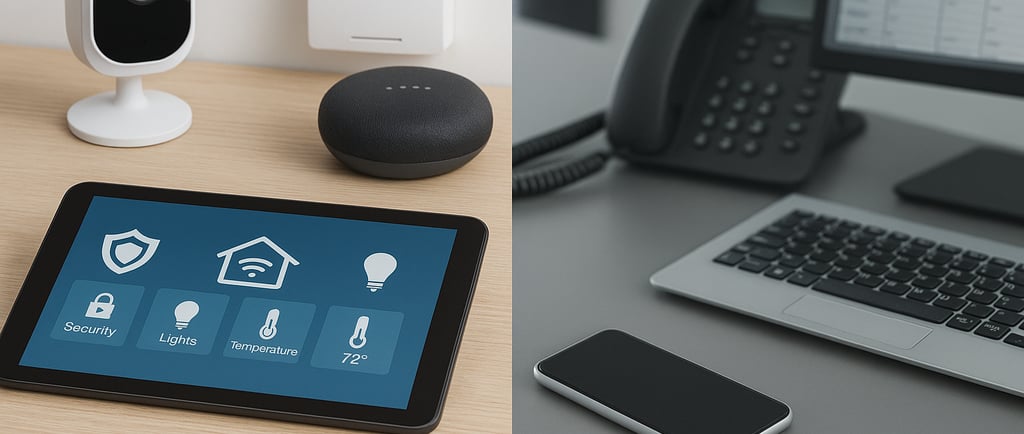Smart Devices, Dumb Mistakes: Securing IoT at Home and Work
TECHNOLOGY


Introduction
Smart devices have transformed both homes and offices—but that convenience comes with risk. From Wi‑Fi cameras and thermostats to connected sensors and employee‑owned phones, the Internet of Things (IoT) opens doors for attackers if security is treated as an afterthought. Let’s explore real-world mistakes and how to avoid them, especially when employees take part in bring your own device (BYOD) policies at work.
Why IoT Is a Growing Risk
As of mid‑2025, there are nearly 19 billion IoT devices in use worldwide—with attacks up 107% in 2024, and some breaches costing $5–10 million each.
Over 50% of IoT devices have critical, exploitable vulnerabilities, and one in three data breaches now involves an IoT endpoint.
Common mistakes like unpatched firmware, default passwords, weak encryption, and insecure APIs still plague devices both at home and work.
Dumb Mistakes That Let Hackers In
Ignoring hardware and firmware
Devices that lack built‑in security or update mechanisms remain vulnerable to known exploits—yet too often go unpatched.Skipping encryption and using weak passwords
Many smart devices transmit or store data unencrypted and still use default or simple password protections.Lacking visibility and inventory
Without actively cataloging every connected device—smart locks, cameras, sensors—attacks can spread silently through your network.Underestimating data sprawl
As IoT and AI tools generate and duplicate data, old or forgotten repositories become ripe targets—with breaches often occurring in unmanaged or unsupervised data stores.Weak network access control (NAC)
Without proper NAC or microsegmentation, compromised IoT devices can grant attackers lateral movement across your network.
Home vs. Workplace: Double Duty, Double Risk
In smart homes, devices often lack enterprise‑grade security and are unmanaged—but once they connect (via guest or VPN access), they can become backdoors into corporate networks.
In offices, BYOD adds another risk layer: employee‑owned phones or tablets compromise hygiene if policies are weak or unenforced.
Practical Defenses and Best Practices
A. For All IoT Deployments
Maintain a device inventory: Log every smart device—home or office—that connects to your network.
Enforce firmware updates: Prefer devices with auto‑patch delivery and schedule regular manual reviews.
Use strong authentication: Disable default credentials, enforce strong passwords or certificate‑based access, and enable multi-factor authentication (MFA) where possible.
Zero Trust + microsegmentation: Treat each device as untrusted by default. Enforce network segmentation—isolating IoT traffic from critical infrastructure.
B. For BYOD Environments
Enforce robust policies: Define which devices and OS versions are allowed, required MDM enrollment, password complexity, encryption, and remote wipe protocols.
Use mobile device or app management: Sandboxing corporate data via MDM or Mobile Application Management helps enforce encryption, DLP, and compliance without invading employee privacy.
Regularly review and update policies: At least annually—or whenever there’s a major breach or tech shift (e.g. post‑quantum standards, new firmware types).
Invest in security training: Educate employees about phishing, security hygiene, safe IoT use at home and work, and how to report suspicious activity.
C. Advanced Measures for Business Environments
Network Access Control (NAC): Centralized control on authentication, authorization, device posture checks, and guest/IoT isolation.
Strict supply‑chain policies: Use devices from manufacturers with strong security records and patch management—avoid obscure vendors or devices with black‑box firmware.
Data governance and AI automation: Use automated tools to track data flows, detect stale or unsanctioned data stores, and enforce retention or classification policies.
Real-World Scenarios
A smart office coffee maker suffering a firmware exploit acts as a pivot point for a larger network breach.
Employees using unsecured home Wi‑Fi with IoT systems like cameras or voice assistants may inadvertently breach corporate security when connecting their devices at home.
A BYOD tablet left unencrypted is lost in transit—without remote wipe or access control, sensitive files are exposed.
Closing Thoughts
Smart devices shouldn’t lead to dumb mistakes. Whether at home or in the office, security cannot be an afterthought. By combining strong inventory processes, rigorous policies, zero‑trust access, user training, and data governance—and properly managing BYOD—you build a resilient layer around IoT ecosystems. That way, you get the benefits of smart technology without becoming the next breach headline.

